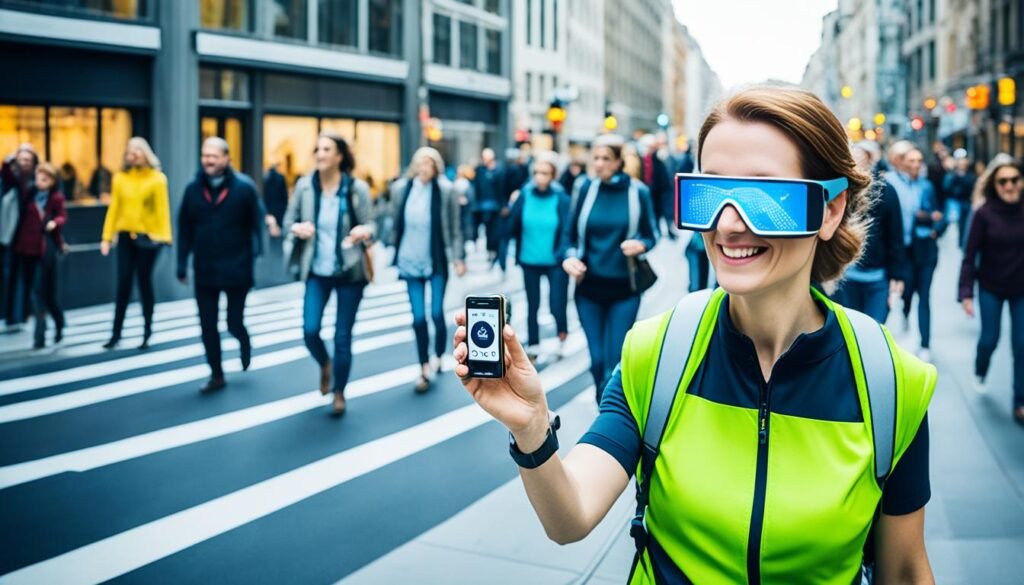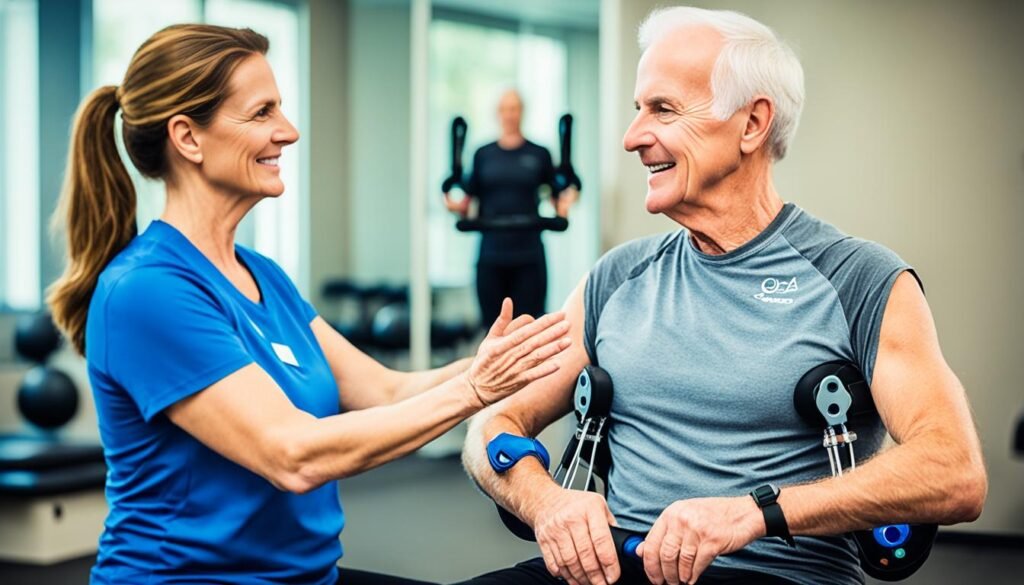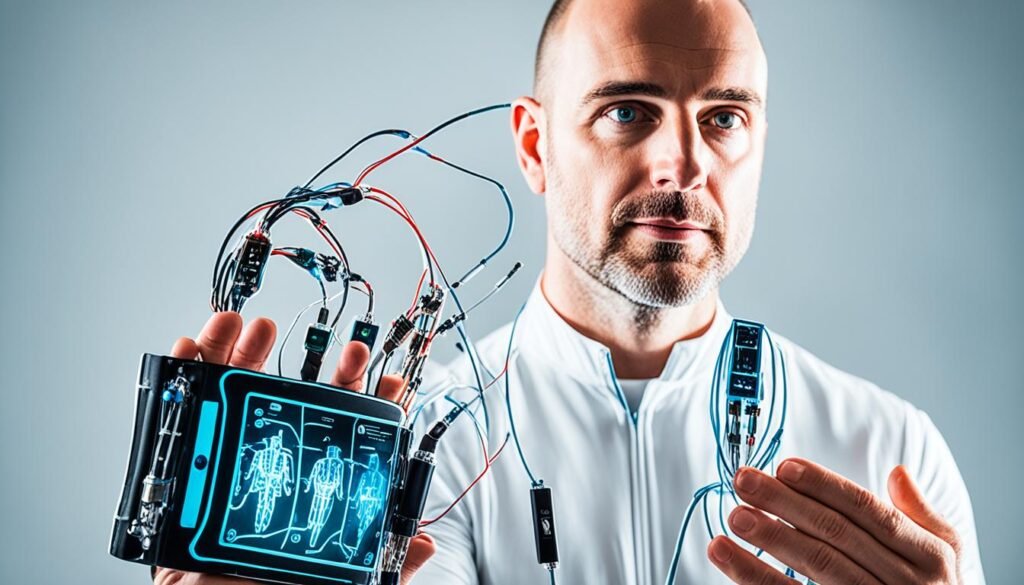About 5% of people have disabling hearing loss1. This has led to a new way to improve how we see and feel the world. Sensory augmentation uses tech like wearable sensors and brain-computer interfaces to give us more sensory info.
For decades, scientists have been working on making technology that helps people with sensory loss1. They’ve gone from simple ideas to advanced devices like the BrainPort. This device helps blind people see by feeling what’s around them1.
People who use these devices, like Roger Behm, say they’ve noticed a big change1. They can now sense things they couldn’t before. New devices, like vests that turn sound into touch, are also making a big difference1.
🎯 Ready to Transform Your Results?
Get the complete system that hundreds have used to achieve breakthrough results.
Get the Book for $7Recently, scientists have come up with new ways to improve sensory skills2. For example, an iPhone app can turn your head movements into sounds, helping you feel your surroundings2.
A study with 56 people tested a device called the feelSpace belt3. It helped users learn about their surroundings in a big city. The goal was to see if this device could improve their understanding of space3.
Research keeps showing that sensory augmentation could change how we interact with the world1. We’re on the edge of a new era in how we perceive and connect with our environment.
Key Takeaways
- Sensory augmentation gives the brain more sensory info to improve how we see and feel things.
- Devices like the BrainPort help blind people feel objects around them.
- Devices that turn sound into touch are making it easier for people to sense their world.
- New tech mimics how our body and senses work together, making experiences feel real.
- Studies show that devices like the feelSpace belt can help people learn about their surroundings.
Introduction to Sensory Augmentation
Sensory augmentation is a fast-growing field that aims to boost human abilities by adding new sensory inputs. It’s about making or changing sensory info to let people see and touch the world in new ways4. By using advanced tech like sensory substitution and haptic devices, it’s changing how we see and move through the world.
Definition and Concepts
Sensory augmentation uses tech to give the brain more sensory info, often by changing one sense into another. This idea, called sensory substitution, started in the 1980s with Paul Bach-y-Rita. He showed that one sense could help us understand the world in ways we’re not used to5. For instance, a system that turns sight into touch lets blind people “see” through touch.
This field also looks at making our senses better. For example, retinal implants boost sight, and cochlear implants help with hearing. By improving our senses, we can experience and interact with the world in new ways.
Historical Background
The idea of sensory augmentation goes way back, with early examples like the white cane for the blind6. But serious research started in the mid-1900s. Pioneers like Theodor Erismann and Paul Bach-y-Rita did key work in the 1930s and 1970s, setting the stage for today’s research6.
In the 1960s, the Elektroftalm system was made, a big step in sensory substitution. Then, Paul Bach-y-Rita’s work in the 1970s led to a system that let the blind feel visual information5.
“The tactile sensory system is an ideal candidate for sensory substitution because of the vast diversity of tactile receptors and their ability to adapt to various stimuli frequencies and intensities.” – Paul Bach-y-Rita5
Today, tech advances have led to better sensory devices. For example, the FeelSpace belt and Neosensory vest use haptics to improve senses and thinking6. These tools have opened new possibilities for people with sensory loss and those wanting to explore more of the world.
The Science Behind Sensory Augmentation

The brain’s ability to adapt and interpret information is key to sensory augmentation. It doesn’t see or hear directly; instead, it uses electrochemical signals from sensory channels to build our view of the world. If the data is meaningful, the brain can learn to understand it, no matter how it comes in7.
This flexibility is why sensory augmentation works, even if our senses are damaged. Technologies like cochlear and retinal implants use this to bring back or boost our senses.
Neuroplasticity and Sensory Processing
Paul Bach-y-Rita’s work in the 1960s laid the groundwork for sensory substitution8. Since then, researchers have explored many ways to substitute or enhance senses, like touch and smell8. These methods aim to help, replace, or even create new senses by using another one7.
Our brains adapt well to these new inputs. Users of sensory substitution devices can feel sensations in the new way, helping them judge distances and shapes7. This makes us wonder about how we perceive things and what sensory substitution can do7.
Brain-Machine Interfaces
Brain-machine interfaces (BMIs) are leading the way in sensory augmentation. They let the brain talk directly to devices, bypassing damaged senses. For example, cochlear implants turn sound into electrical signals for the ear nerve, helping people with hearing loss.
Retinal implants also work by stimulating the retina with electrodes, sending visual info to the brain. As BMI tech gets better, it could change how we see or hear, like adding new colors to our sight or improving hearing.
The feelSpace belt and NorthSense by CyborgNest let users feel magnetic north through touch, adding a new sense of direction9.
Haptic tech uses motors and other devices to create touch sensations. It’s a key part of sensory substitution and enhancement8. These systems can make touch feedback realistic, making experiences more immersive8.
Haptic tech has many uses, from helping people to virtual reality and gaming8. As it gets better, it could make touch sensations more real and detailed, making its way into more areas of life8.
| Sensory Augmentation Technology | Developer(s) | Function |
|---|---|---|
| VEST (Vestibular Extra-Sensory Transducer) | Scott Novich and David Eagleman | Turns sound into back vibrations, letting people feel words and music9 |
| feelSpace belt and NorthSense | Peter König and Liviu Babitz (CyborgNest) | Helps users feel magnetic north through touch, introducing magnetoreception9 |
| Eyeborg | Neil Harbisson | Allows the user to hear colors through bone conduction, expanding perception to infrared and ultraviolet9 |
Sensory augmentation isn’t just for helping people. Neil Harbisson’s eyeborg lets him hear colors and see infrared and ultraviolet, changing how he experiences the world9.
As we learn more about the brain and improve technology, sensory augmentation could do a lot more. But we must think about the ethics, making sure it’s fair, private, and unbiased8.
Sensory Substitution Devices
Sensory substitution devices are new ways to help people with lost senses. They use another sense to give information, making it easier for those with sensory loss to understand the world10. Since the 1960s, scientists have been working on these devices to improve life for people with sensory disabilities10.
Vision-to-Touch Systems
The BrainPort is a device that turns what a camera sees into touch on the tongue. It lets blind people feel what they can’t see, giving them a new way to explore the world11. The Forehead Retina System uses vibrations on the forehead to send visual info, helping those who can’t see in a new way.
Studies show these devices help people with vision loss enjoy art more. A study by Cho JD found they improved how visually impaired people see colors and enjoy art12.
Sound-to-Touch Devices for the Deaf
For those who can’t hear, sound-to-touch devices let them feel sounds. The vibrotactile vest and the Neosensory Buzz wristband turn sounds into skin vibrations. This lets deaf people feel their surroundings in a new way.
Rooth MA’s study showed how these devices can make life better for older people with vision and hearing loss12. They can help people stay independent and connect with others.
Braille is a classic example of sensory substitution, giving the blind touch information about words10.
Sensory substitution devices could change how people with sensory loss interact with the world. With technology and our knowledge of how the brain works, we can expect more solutions. These will help people with sensory disabilities live more fully and independently.
Sensory Expansion Technologies

Sensory expansion technologies are changing how we see the world. They let us sense things we can’t normally feel or see. By using new tech in neuroscience, engineering, and computing, we’re making devices that let us see beyond our usual limits13.
Extending the Visual Spectrum
One exciting area is making devices that let us see beyond what we can see. Scientists are working on tools that turn invisible light into something we can see13. This could let us see heat or things in the ultraviolet spectrum, which we can’t see now.
These technologies could change many things. They could help us see better in the dark or spot hidden details. They could also change how we study animals, letting us learn more about their lives13.
Enhancing Auditory Perception
For hearing, sensory tech aims to make us better at picking up sounds. Researchers are making hearing aids and directional microphones that focus on certain sounds and block out the rest14. These could help people with hearing loss or make hearing better for everyone.
Imagine being able to tune into distant conversations or detect subtle changes in the environment through enhanced auditory perception.
There’s also interest in using tech to change how we taste food15. By mixing smells, tastes, and sights, we could change how food tastes. This could lead to new kinds of food and better dining experiences15.
| Sensory Expansion Technology | Description | Potential Applications |
|---|---|---|
| Infrared Vision | Devices that detect and translate infrared wavelengths into visible signals | Enhanced navigation, wildlife observation, security features detection |
| Ultraviolet Perception | Technologies that enable perception of ultraviolet light patterns and details | Scientific research, art authentication, forensic analysis |
| Directional Hearing | Advanced hearing aids and microphones that improve directional sound processing | Assisting hearing-impaired individuals, enhancing auditory experiences |
Sensory expansion tech is getting better all the time. It could change how we see, hear, and even taste the world. These new ways of perceiving could change many areas, from science to art, making our sensory experience richer13.
Sensory Addition: Introducing Novel Senses
Imagine seeing the world in new ways, beyond what we’re used to. Sensory addition technologies aim to give us new senses. This could change how we see, hear, touch, taste, smell, and even feel the world.
Magnetoreception is one area being explored. It’s how some animals, like birds and sea turtles, sense magnetic fields10. Scientists are working on making this sense available to humans too. Just think of always knowing where you are and where you’re going.
Another area is electromagnetic fields. Our world is full of these invisible fields from things like phones and power lines. A new sense could let us see them, giving us new insights into our surroundings.
“The promise of modern technology is to provide powerful tools to replace or expand senses10, and sensory augmentation aims to create novel senses or enhance existing ones10.”
Pressure sensing is also being looked into. It could help us feel tiny changes in pressure, useful in many areas like medicine and sports. Just imagine feeling changes in air or water pressure in a new way.
Researchers are also exploring radiation detection. While too much radiation is bad, being able to sense it could be useful. It could help us stay safe by letting us know about dangers around us.
Since the 1960s, scientists have been working on devices to help or give us new senses7. These devices let us experience the world in new ways using senses we already have7. They’ve helped us learn more about how we perceive things and how our brains work7.
The field of sensory augmentation is very promising. It could greatly expand what we can do and how we see the world. As technology gets better, we might soon have new senses that let us experience things in ways we can’t imagine.
Applications in Assistive Technology

Sensory augmentation technologies are changing the game in assistive tech, especially for those with vision or hearing loss. They boost spatial awareness, help with navigation, and offer new ways to experience the world. This lets people with sensory challenges live more independently and fully.
Aiding the Visually Impaired
For those who can’t see well, tools like the BrainPort and Forehead Retina System are key. They turn visual info into touch or sound, helping users understand their world in new ways12. This lets them move around safely and on their own12.
Intelligent systems for the visually impaired also prevent collisions and detect falls12. They use computer vision and learning to watch the user’s space, alerting them to dangers12. With these tools, visually impaired people can move around more freely and safely12.
Enhancing Mobility for the Deaf
Deaf people need to feel sounds to stay safe and aware. Devices that turn sounds into skin vibrations change the game, letting them feel alarms or cars coming12. This helps them stay safe and aware.
AI-powered tech is also changing the lives of those who are hard of hearing16. Tools that predict text with gestures make talking easier and faster for the deaf16. These smart systems make learning and socializing more accessible16.
| Assistive Technology | Target Population | Key Benefits |
|---|---|---|
| BrainPort and Forehead Retina System | Visually Impaired | Enhances spatial awareness and navigation |
| Intelligent Assistive Systems | Visually Impaired | Aerial obstacle avoidance and fall detection |
| Sound-to-Touch Devices | Deaf Individuals | Converts auditory cues into tactile feedback |
| AI-powered Gesture-Based Text Prediction | Deaf Individuals | Facilitates natural communication and inclusive education |
Sensory tech in assistive devices is a big step towards a more open and easy-to-reach world. It helps people with vision or hearing loss move, talk, and learn with confidence. These innovations are changing lives and making assistive tech better for everyone.
Potential for Human Enhancement
Sensory augmentation technologies are getting better and could greatly improve our thinking and senses. They add new sensory inputs, helping us process information better. This could make us see, hear, and feel things in new ways, enhancing our senses.
Augmenting Cognitive Abilities
These technologies could boost our brain power. By giving us more sensory info, they help us understand our world better. This could make learning, solving problems, and making decisions easier.
But, people have mixed feelings about this. 78% of Americans don’t want a computer chip to boost their brain power17. Also, 56% think brain chips for thinking better are a bad idea, while 13% like it17.
Still, research goes on. Some think these technologies could even make us experience synesthesia, where one sense affects another. This could change how we see and interact with things. A study looked at how people view augmented humans and found opinions vary based on the type of upgrade and if someone has a disability18.
Expanding Sensory Experiences
Sensory augmentation could also make our experiences richer. By making us more sensitive, we could notice tiny changes in our surroundings. This could make learning, fun, and art more engaging.
Imagine seeing more colors, hearing sounds we can’t now, or feeling new textures. This could lead to new art, better education, and more fun entertainment. The study aimed to design tech that works for everyone, including people from different cultures and places18.
| Augmentation Type | Potential Applications |
|---|---|
| Sensory | Enhancing visual, auditory, and tactile perception |
| Motor | Improving physical abilities and coordination |
| Cognitive | Augmenting memory, attention, and problem-solving skills |
As we look into sensory augmentation, we must think about its ethics and effects on society. Some Americans are excited, some worry, and some are unsure about it17. Also, many worry about gene editing healthy babies to prevent diseases19. We need to talk more and think carefully about the future of enhancing humans.
Sensory Augmentation in Rehabilitation

New technologies are changing how we help people with neurological disorders and stroke recovery. They add sensory feedback to help with motor skills and brain healing. This leads to better recovery and a better life for patients20.
Age-related falls cost over $50 billion a year, showing we need good rehab strategies21. Exercises that focus on balance and strength help older adults stay steady and fall less21. But, these programs can be expensive and hard to get to21.
Vibrotactile sensory augmentation (SA) is showing great promise. It helps people with balance issues stay steady and balance better, and the effects last for up to three months21. In a study, 32 people (18 women, 14 men) across three age groups tested how well they felt vibrations at different body spots22.
Sensory augmentation is a game-changer in rehabilitation, offering new hope for individuals with neurological disorders and those recovering from stroke.
Virtual reality (VR) balance training with a dynamic balance board has made a big difference for people with Parkinson’s disease21. People with balance problems have gotten better in clinical tests and balance skills after doing vestibular rehab exercises21.
| Intervention | Outcome |
|---|---|
| Vibrotactile SA training | Greater improvements in SOT scores, Mini Balance Evaluation Systems Test scores, and Five Times Sit to Stand Test duration compared to control group21 |
| Six-week vestibular rehabilitation with vibrotactile SA | Significant improvements in experimental group compared to control group21 |
| Eight-week in-home balance training with wearable vibrotactile SA | Balance improvements for healthy older adults21 |
As we learn more about sensory augmentation, it’s clear these technologies are key in rehab. They boost sensory feedback and help the brain heal. This means better recovery and a better life for people with neurological disorders and stroke.
Ethical Considerations and Debates
Sensory augmentation technologies bring up big ethical questions. They make researchers, policymakers, and the public talk a lot. In the last 30 years, tech like nanotech and biotech has grown fast. This has made people think about what it means to enhance humans23.
Now, governments are looking into how these enhancements affect society. They’ve been doing this for about a decade, showing they’re really interested and worried23.
One big worry is making sure everyone can use these technologies. The cost might make it hard for some people to get them. This could make things worse for those who are already behind24.
We need to make sure everyone can get to these technologies. This means making policies that are fair and watching over these technologies carefully24.
Blurring the Lines Between Therapy and Enhancement
It’s getting harder to tell when something is a therapy or an enhancement. As these technologies get better, we’re asking big questions. Questions like, what does it mean to be us? And what’s fair23?.
Experts in many fields are talking about this a lot. They’re looking at things like in-vitro fertilization and abortion. They want to figure out the right role for medicine in our lives23.
The experts have come up with some rules for using these technologies. They focus on freedom, helping the public, being responsible, and being fair24.
There’s a big worry that these technologies could make society more divided. As they get better, they could change our economy and society a lot23. We need to make sure we’re thinking about everyone’s freedom and what’s best for society24.
We need to keep talking about these issues. We should work together to make rules that help us use these technologies right24. By thinking carefully, we can try to avoid problems and make sure people can live their lives fully24.
Current Research and Development

The field of sensory augmentation is moving fast. Researchers and engineers are working hard to make new things possible. They focus on making devices smaller, wireless, and more energy-efficient. They also work on making them comfortable to wear and easy to use every day.
Cutting-Edge Sensory Augmentation Projects
A new brain device is being tested to improve how we sense things. It uses a technique called transcranial electrical stimulation (TES) to help us see better25. The device is being tested to see if it can make us better at detecting objects and people.
Another study is looking at a system called Vision360. It turns what we see into sounds, helping the blind to “see” the world26. The test was done in a special room with speakers and a projector26. This system changes colors into sounds, helping people know where things are around them26.
Challenges and Limitations
Even with these new advances, sensory augmentation has its challenges. People need to learn how to use the new senses well. Too much new information can be overwhelming. If the device doesn’t work right, it could cause confusion or safety problems.
Researchers are trying to make these devices easier to use and safer. They want to make sure they don’t get too much information. Studies show that using both hearing and touch can help people do better12. They are also learning more about how to make these devices better at helping people see and hear the world12.
Overcoming these challenges will be crucial for the successful development and widespread adoption of sensory augmentation technologies, enabling individuals to expand their perceptual capabilities and interact with the world in entirely new ways.
Future Directions and Possibilities

Sensory augmentation technologies are moving fast, opening up new possibilities for the future. The market for these technologies is expected to grow a lot by 202627. This growth is thanks to advances in prosthetics, hearing devices, bioprinting, and exoskeletons27. Direct neural interfaces are a key area to watch, promising to connect more deeply with our brains for better sensory experiences28.
Combining sensory augmentation with virtual and augmented reality could change how we learn, train, and have fun. Companies are exploring how VR, AR, and mixed reality can enhance human abilities28. With 5G’s faster speeds and stronger connections27, these technologies could change how we see and interact with the world.
Artificial intelligence could make sensory augmentation better by tailoring it to each person’s needs. Edge computing will be key for things like self-driving cars and AR27. Sharing sensory experiences could change fields like science, art, and design, leading to new creativity and discoveries.
“The future of sensory augmentation lies in the seamless integration of technology with the human body and mind, creating a world where the boundaries between the digital and physical realms are blurred.”
Looking ahead, brain-to-brain communication could revolutionize how we connect with each other. Brain implants are already helping with memory, decoding brain signals, and creating speech, showing big leaps in brain technology28.
But, we must think about the ethical and risky sides of these technologies. Using CRISPR and nootropics raises big ethical questions28. There are also worries about privacy as more personal data is shared28. It’s important for those using these technologies to think about security and follow new rules28.
| Technology | Future Potential | Challenges |
|---|---|---|
| Direct Neural Interfaces | Seamless integration with the brain for immersive sensory experiences | Ethical considerations, privacy concerns, and long-term health impacts28 |
| Virtual and Augmented Reality | Powerful tools for education, training, and entertainment | Ensuring accessibility and equity in access to these technologies28 |
| Artificial Intelligence | Optimization and personalization of sensory augmentation | Addressing potential biases and ensuring responsible development |
| Collaborative Sensory Experiences | Transforming scientific research, art, and design through shared experiences | Developing secure platforms for sharing sensory data |
We need to talk openly about the effects of sensory augmentation technologies. We should create rules for their use to make sure they help us without harming us. By doing this, we can use these technologies to improve our lives while keeping everyone safe.
The Impact on Society and Culture
Sensory augmentation technologies are changing society and culture. They help people with hearing loss and vision problems live better lives29. These technologies let people access information and move through the world in new ways. This can change how we see disability and make society more inclusive.
The idea of augmented humanity aims to make people happier by improving their lives30. It’s about making sure everyone, in all aspects of life, is treated equally.
Changing Perceptions of Disability
More people using sensory augmentation could make us value sensory differences more. It could also change how we see the human experience. These technologies help people with sensory issues connect with the world in new ways.
This can make society more welcoming and understanding. But, we must make sure these technologies are developed and shared fairly. This means making sure they’re available to everyone and that they don’t leave some behind29.
Reshaping the Human Experience
Being able to sense more can change how we see the world and our role in it. It might make us question what it means to be human. We could think differently about our potential as a species.
As we explore these new ways of experiencing the world, we need to talk and think deeply. We should make sure these technologies match our values. They should help us become a more enlightened society.
FAQ
What is sensory augmentation?
Sensory augmentation uses technology to give us more sensory inputs. It helps us see, hear, touch, taste, and smell better. This can also give us new senses.
How does the brain adapt to new sensory inputs?
Our brains can change to understand new kinds of information. This is called neuroplasticity. If the information is useful, our brains can learn to make sense of it, even if it’s from a new sense.
What are some examples of sensory substitution devices?
Devices like the BrainPort turn visual info into touch on the tongue. Others, like the vibrotactile vest, turn sounds into skin vibrations.
How can sensory expansion technologies enhance human perception?
These technologies make us see and hear more. They let us see infrared and ultraviolet light and hear sounds we couldn’t before. This makes our senses wider.
What are some potential novel senses being explored in sensory addition?
Scientists are working on giving us new senses. This includes feeling magnetic fields, electromagnetic fields, and more. These could change how we see the world.
How can sensory augmentation technologies benefit individuals with sensory impairments?
These technologies can really help people who are blind or deaf. For example, they can turn sounds into touch, helping with navigation and safety.
What are the potential applications of sensory augmentation beyond assistive technology?
These technologies can do more than just help people with disabilities. They can make our senses stronger and our brains work better. This could make learning and fun activities more exciting.
How can sensory augmentation technologies be used in rehabilitation?
These technologies can help people recover from strokes or brain injuries. They can give feedback to help with movement and balance.
What are some ethical considerations surrounding sensory augmentation?
There are big questions about these technologies. Who gets to use them? How do they change our sense of self? And what are the risks?
What are some current challenges and limitations in sensory augmentation research and development?
There are still problems to solve. Users need training, and there’s a risk of too much information. Researchers are working on making devices smaller and more reliable.
How might sensory augmentation technologies impact society and culture in the future?
These technologies could change how we see disability and include everyone. They could make us appreciate different senses more. This could change our idea of what it means to be human.
